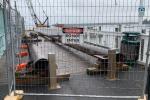For those Mounties who like to establish their mana with a mean manu, Salisbury Wharf in Pilot Bay is open once again and back in business.
Mount Maunganui residents, fishers, boaties and dive bombers will once more be able to bike to and berth at the popular wharf following recent improvements by Tauranga City Council.
Work to replace stairs and piles, which started in early August, was finally finished this week.
“The Covid lockdown and weather caused some delay on that finish date,” says Tauranga City Council project manager Scott McCauley.
A condition assessment done on Salisbury Wharf, thought to have been built in the 1970s, identified piles that had deteriorated to the point of replacement.
“As well as those piles, we’ve replaced both sets of stairs - the southern stairs which face the port and the port pilot boats, and the stairs on the western side which face out over the harbour.”
Some of the bearers and joists, which are part of the structural work underneath the wharf, were also repaired.
Long pipes lying the length of the wharf were used to suspend loads underneath and were removed on completion. Like most structures, it will require maintenance in the future.
“They used the pipes as a structural element and attached rods which go through the deck of the wharf, so they can hang a working platform underneath. The pipes take the weight of that platform.”
The reason for the work is due to Toredo navalis, the naval shipworm, also known as the termite of the sea.
Ever since man first ventured out to sea, the boring clam has weakened unprotected wood submerged in water. Left alone, they would eventually cause serious damage, hollowing out the inside of some of the piles which would eventually have fallen over, causing the wharf to collapse.
“Normally you can get between 25 and 30 years on a treated timber pile,” says Scott.
“A lot depends on the environment they’re in, what the sand type is, and what organisms are living in the sand. Where the pile enters the sand is where they get damaged.
“We’ve put H6 treated pile in there. It’s the best you can use for marine environments.”
He’s optimistic that there’s 25 years of life in the new piles.
The fender piles that sit on the outside of the wharf, which boats use to moor up against, have also been replaced.
“They protect the structure of the wharf, so that boats are mooring against them rather than the structure of the wharf itself. We replaced four of them along the western face of the wharf.”
Following a final inspection, the contractors demobilised the barge, pulled down the fencing, and removed the pipes and barge off site.
“We’ve completed the final inspection, we’re happy with everything, and the wharf is open again,” says Scott.
Source: SunLive.co.nz

